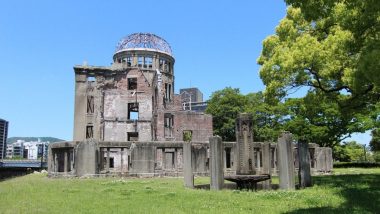Gawking at a disaster with sympathy is unfortunately a part of human nature. It's fascinating for many to look at the tragedy with a frown on the forehead and none in the heart. And out of this desire has arisen, disaster tourism. From natural disasters to man-made ones, tragic incidents around the world has been attracting tourists since quite some time. Disaster tourism is generated from the aftermath of a major disaster or traumatic event. Some of the examples of disaster tourism include Chernobyl's Exclusion Zone in Ukraine, war zones in Iraq and Afghanistan, holocaust concentration camps in Europe, battlefield sites among many others. Last Chance Tourism: Boon and Bane of This Growing Trend Among Travellers That Affects Tourist Spots.
Photography has played a big role in making these dark tourism sites quite popular. Pictures have been making sites of disaster famous since the Second World War and continue to be a good storyteller. It is also loosely related to dark tourism which is also known as black tourism or grief tourism. Dark tourism is primarily related to travelling to places historically associated with death or tragedy. However, unlike disaster tourism, the main attraction of dark tourism is the historical value of the place over death and suffering. Last Chance Tourism: From Great Barrier Reef to Machu Picchu, 7 Places People Are Visiting Before They're Lost Forever Due to Climate Change!
The Insensitive Nature of Disaster Tourism
Recently, Instagrammers came under the fire for posing into the front of the nuclear disaster site Chernobyl and posting the pictures on social media. The disaster site became after SKY UK/HBO miniseries Chernobyl which traces what led to the nuclear accident on April 26, 1986, in the Chernobyl Nuclear Power Plant, near the city of Pripyat in the north of the Ukrainian SSR. Social media influencers were called insensitive for treating the place as yet another photoshoot location. While many tried to defend their actions, the incident kickstarted debates on the terrible nature of disaster tourism.
Other than behavioural issues of people, these sites may pose an actual danger to visitors. If it's a place that just witnessed an earthquake, flood or similar disaster, visiting such places is not recommendable. While rubbernecking is a natural reaction, it can lead people into dangerous situations. Hiroshima Day 2019: History, Facts and Pictures of the Japanese City Bombed During World War 2.
The Other Side of Disaster Tourism
Although disaster tourism comes with an array of social issues, it also has a positive side. The arrival of visitors at ravaged sites pumps money into the local economy. The interest of a section of people will help another group in building back their lives. This will be useful once the emergency has passed and the region is getting back to normalcy. It also helps in spreading information about the place. The region stands as a living symbol of the catastrophe which occurred there. And in case of a man-made one, it tries to tell the future generation to not repeat the same mistake.
Some of the places popular for disaster tourism includes Fukushima Daiichi nuclear disaster, Nevada National security site, Hiroshima Peace Memorial in Japan and Pompeii in Italy. While disaster tourism feeds on the curiosity of the people to peep at the apathy of the less privileged, it has another side that helps in keeping the economy going. It depends on the traveller how they plan to treat the place and return as better informed people.
(The above story first appeared on LatestLY on Aug 18, 2019 06:00 PM IST. For more news and updates on politics, world, sports, entertainment and lifestyle, log on to our website latestly.com).













 Quickly
Quickly


